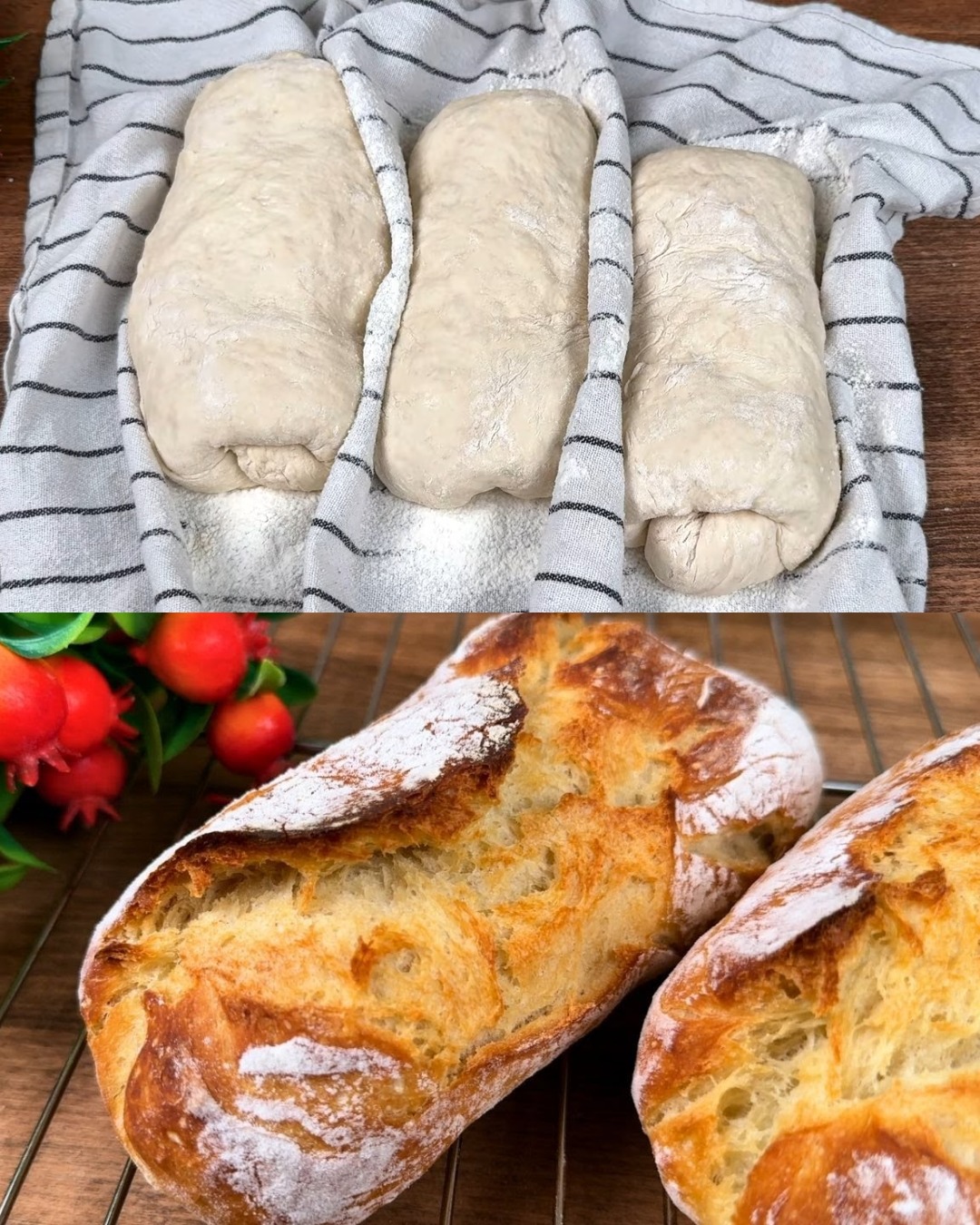Few things compare to the simple joy of freshly baked bread—crisp on the outside, soft and airy on the inside, and delightfully fragrant. This No-Knead Artisan Bread recipe delivers all that, and more, without requiring complicated techniques or specialized equipment. Using only four pantry staples—flour, yeast, salt, and water—this bread is a beginner-friendly gateway into the world of artisanal baking. It’s perfect for anyone who craves bakery-quality bread from the comfort of their own kitchen.
What makes this method unique is its simplicity: you skip kneading entirely and instead rely on a long, slow fermentation to build gluten and flavor. With just a few folds and a cold overnight rest, this bread develops a rich, slightly tangy taste and an open, chewy crumb. Baked in a preheated Dutch oven, it achieves a professional crust that crackles beautifully when cooled. Whether you’re making avocado toast, mopping up soups, or just enjoying it with butter, this loaf is an everyday luxury worth mastering.
Cooking Time
-
Preparation Time: 15 minutes (active)
-
Resting & Rising Time: 9–13 hours total
-
Baking Time: 40 minutes
-
Total Time: Approximately 10–14 hours (mostly inactive)
Ingredients
-
500 g bread flour (Type 550 or similar high-protein flour)
-
6 g (1½ tsp) dry yeast
-
375 ml lukewarm water (35–40 °C / 95–104 °F)
-
10 g (1 tbsp) fine salt
Step-by-Step Cooking Directions
1. Mix the Dough
In a large mixing bowl, combine the bread flour, dry yeast, and salt. Add the lukewarm water and mix with a wooden spoon or silicone spatula until a shaggy, sticky dough forms. This dough will be wet and uneven—don’t worry, it’s meant to look rough at this stage.
2. First Rise at Room Temperature
Cover the bowl with plastic wrap or a damp kitchen towel and let it sit at room temperature (around 20–22 °C or 68–72 °F) for 30 minutes. This initial rest kickstarts the fermentation and allows the flour to absorb the liquid, making the dough easier to work with.
3. Stretch and Fold (x3)
After 30 minutes, with lightly oiled or wet hands, perform your first set of stretch-and-folds: gently grab one side of the dough, stretch it upward, then fold it over the center. Rotate the bowl and repeat this motion on all four sides. Cover the dough again and let it rest another 30 minutes.
Repeat this stretch-and-fold process two more times at 30-minute intervals. These folds help develop gluten strength without kneading.
4. Cold Fermentation (Overnight)
After the final stretch-and-fold, cover the bowl and refrigerate the dough for 8 to 12 hours. This slow, cold fermentation is the key to developing a deeply flavorful bread with great texture.
5. Shape and Second Rise
Remove the dough from the fridge and turn it out onto a generously floured surface. Be gentle to preserve the air bubbles. Shape the dough into a round ball by folding the edges underneath, forming surface tension. Place the dough seam side down on parchment paper. Cover loosely and allow it to rest at room temperature for 30–45 minutes.
6. Preheat the Oven and Dutch Oven
While the dough is resting, preheat your oven to 230 °C (450 °F) with a heavy-duty Dutch oven (with its lid on) inside. Preheating the pot is crucial for getting a good oven spring and crisp crust.
7. Bake the Bread
Using oven mitts, carefully remove the Dutch oven and take off the lid. Use the parchment paper to lift the dough and lower it into the hot pot. Cover with the lid and bake for 30 minutes.
After 30 minutes, remove the lid and continue baking for 10–15 minutes until the crust is a deep golden brown.
8. Cool and Serve
Lift the bread out by its parchment and place on a wire rack. Let it cool for at least 1 hour before slicing. This rest allows the steam to escape and the crumb to set, preventing gummy texture.
Nutritional Information (Per Slice, based on 12 slices)
-
Calories: 160 kcal
-
Carbohydrates: 32 g
-
Protein: 5 g
-
Fat: 0.5 g
-
Fiber: 1.5 g
-
Sodium: 230 mg
The Origins and Popularity of the Recipe
No-knead bread became a global trend after Jim Lahey of Sullivan Street Bakery introduced the technique in the early 2000s. The idea of letting time and moisture develop gluten—rather than kneading—revolutionized home bread baking. The method gained widespread attention when featured in The New York Times, as it allowed amateur bakers to produce bakery-quality loaves using just a Dutch oven and simple ingredients. Its popularity has only grown, with countless variations now available online.
Reasons Why You’ll Love This Recipe
-
No kneading required—great for beginners
-
Bakery-style crust and open crumb at home
-
Only 4 ingredients
-
Adaptable to whole wheat, seeds, or herbs
-
Incredibly versatile and stores well
Health Benefits
While white bread isn’t always considered a health food, making your own loaf at home offers several benefits:
-
No preservatives or additives
-
Lower sodium compared to store-bought options
-
Can control ingredients for dietary needs
-
Slow fermentation improves digestibility
-
Pairs well with fiber-rich foods
Serving Suggestions
-
With butter and jam for breakfast
-
As a base for sandwiches or paninis
-
Paired with soups like tomato, lentil, or minestrone
-
Dipped into olive oil and balsamic vinegar
-
Toasted with avocado, eggs, or cheese
Common Mistakes to Avoid
-
Using hot water: can kill yeast
-
Skipping the stretch-and-fold: reduces structure
-
Not preheating the Dutch oven: prevents proper oven spring
-
Overhandling the dough after cold fermentation
-
Cutting too soon after baking: can ruin the texture
Pairing Recommendations
-
Wine: Sauvignon Blanc or Chardonnay
-
Cheese: Brie, cheddar, or burrata
-
Spread: Hummus, pesto, or compound butter
-
Soup: French onion, butternut squash, or vegetable
-
Protein: Roast chicken, grilled vegetables, or smoked salmon
Cooking Tips
-
Use a digital scale for accurate flour and water ratios
-
If your flour is Type 405 (low protein), reduce water slightly
-
For a crisper crust, let the bread cool completely uncovered
-
To store, wrap in a towel or keep in a bread bag—avoid plastic
-
Toasting stale slices brings them back to life
Similar Recipes to Try
-
Whole Wheat No-Knead Bread
-
Rustic Rye Sourdough
-
Olive and Rosemary Artisan Bread
-
Seeded Multigrain Dutch Oven Loaf
-
Garlic Herb Focaccia
Variations to Try
-
Add seeds: sunflower, flax, sesame, or pumpkin
-
Incorporate herbs: rosemary, thyme, or oregano
-
Add-ins: olives, roasted garlic, or dried fruit
-
Whole grains: Substitute 100–200 g of flour with whole wheat or spelt
-
Sweet option: cinnamon-raisin with honey
Ingredient Spotlight
Bread Flour (Type 550)
Higher in protein (about 11–13%) than all-purpose flour, bread flour gives the dough structure, chewiness, and excellent rise. Type 550 is commonly used in German and European baking and produces a robust, airy crumb perfect for crusty loaves.
Dry Yeast
Instant dry yeast is easy to work with and doesn’t require proofing. It activates quickly with warm water and works beautifully in long, slow ferments.
Advertisement
Salt
Salt not only flavors the bread but also regulates yeast activity and strengthens gluten. Be precise, as too much or too little can affect texture and taste.
Water
Lukewarm water (not hot!) activates yeast without killing it. Always measure it for the best hydration and crumb development.
Conclusion Paragraph
This No-Knead Artisan Bread is a brilliant combination of ease and excellence. Without any kneading or complicated steps, you’ll create a crusty, chewy, flavorful loaf that rivals any bakery. Whether you’re a seasoned baker or just beginning your bread journey, this recipe is forgiving, flexible, and completely satisfying. With a little patience and the right timing, you can enjoy rustic, homemade bread any day of the week.

